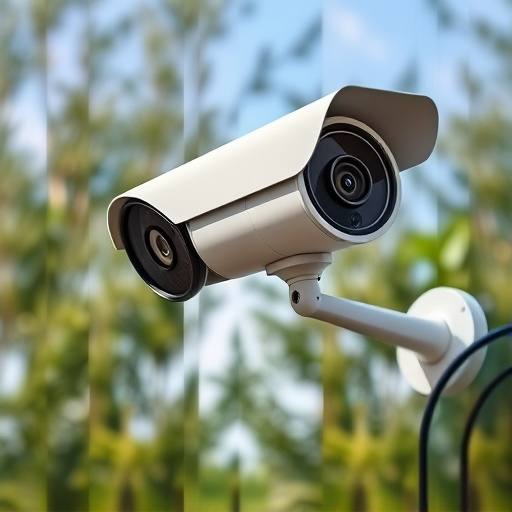Solar-powered dummy security cameras offer a self-sufficient, eco-friendly solution for home and business surveillance with motion detection, waterproof design, and easy installation via the included Dummy Camera Bracket Installation Guide. To ensure optimal performance, select sunny locations facing south (Northern Hemisphere) or north (Southern Hemisphere), maintain clear access for maintenance, and follow the guide for proper mounting height. Integrate a solar panel for consistent power supply and conduct regular tests and maintenance to keep cameras operating efficiently.
“Discover the benefits of solar-powered dummy security cameras, a sustainable and effective way to enhance your home or business security. This comprehensive guide explores how these innovative devices work, from understanding their key features to choosing the perfect installation spot. Learn about the step-by-step process of installing a dummy camera bracket, integrating solar panels for power, and maintaining optimal performance. Get ready to explore the world of eco-friendly surveillance with our detailed Dummy Camera Bracket Installation Guide.”
- Understanding Solar-Powered Dummy Security Cameras: Benefits and Features
- Choosing the Right Location for Installation: Considerations and Best Practices
- Step-by-Step Guide to Installing a Dummy Camera Bracket
- Integrating Solar Power: Connecting Panels and Batteries
- Testing and Maintenance Tips for Optimal Performance
Understanding Solar-Powered Dummy Security Cameras: Benefits and Features
Solar-powered dummy security cameras are an innovative addition to home and business security systems, offering a range of benefits that traditional wired cameras can’t match. One of their key advantages is the self-sufficiency they provide; powered entirely by solar energy, these cameras eliminate the need for messy and costly electrical wiring, making them particularly appealing for outdoor installations. This eco-friendly approach not only reduces carbon footprint but also provides a level of flexibility in camera placement, as they can be set up almost anywhere with access to sunlight.
These dummy cameras come equipped with advanced features designed to enhance security and peace of mind. Motion detection technology ensures these devices activate only when necessary, conserving precious battery life. Additionally, their waterproof design makes them durable against all weather conditions, guaranteeing year-round surveillance. The Dummy Camera Bracket Installation Guide further simplifies the setup process, allowing users to effortlessly integrate these solar-powered cameras into their security infrastructure without professional assistance.
Choosing the Right Location for Installation: Considerations and Best Practices
When installing a solar-powered dummy security camera, selecting the optimal location is key to ensuring its effectiveness and longevity. The first step involves assessing the site’s accessibility for both sunlight exposure and power connection. Solar panels require ample direct sunlight to charge efficiently, so choose a spot with minimal obstructions from trees or buildings during daylight hours. Ideally, face the camera towards the south (in the Northern Hemisphere) or north (Southern Hemisphere) for maximum sun exposure.
Additionally, consider proximity to your property line and any potential viewing angles for better monitoring. Ensure there’s easy access for maintenance and repairs by selecting a location that allows comfortable bracket installation, typically achieved through a dummy camera bracket guide. Proper mounting height is also crucial; positioning the camera at eye level or slightly elevated can provide a wider field of view and clearer footage.
Step-by-Step Guide to Installing a Dummy Camera Bracket
Integrating Solar Power: Connecting Panels and Batteries
Integrating solar power into your dummy security camera setup involves a straightforward process of connecting solar panels and batteries. Begin by installing the solar panel on a location that receives ample sunlight—rooftops or open spaces are ideal. Ensure the panel is securely fastened using the provided Dummy Camera Bracket Installation Guide, aligning it with optimal sun exposure for maximum energy generation.
Once the panel is in place, connect it to the camera’s power source through a battery system. Many solar-powered cameras come with rechargeable batteries that can store excess solar energy during the day for nighttime surveillance. Properly wire the system according to the manufacturer’s instructions, ensuring safety and efficiency. This integration not only provides consistent power but also makes your security setup environmentally friendly and cost-effective.
Testing and Maintenance Tips for Optimal Performance
To ensure optimal performance from your solar-powered dummy security cameras, regular testing and maintenance are crucial. Start by checking the camera’s power source – the solar panel – for any obstructions or damage that could impede sunlight absorption. Keep the panel clean and free from debris to maximize energy harvesting. Additionally, inspect the battery regularly, ensuring it retains a healthy charge; consider using a smart battery monitor to stay updated on its status.
When it comes to installation, follow a Dummy Camera Bracket Installation Guide for a secure setup. Regularly tighten connections at the bracket and camera to prevent loose parts that could affect performance. Clean the camera lens periodically with a soft, dry cloth to maintain clear visuals. Lastly, be mindful of extreme weather conditions; while solar-powered cameras are designed for outdoor use, prolonged exposure to harsh weather may require additional protective measures or indoor placement during severe seasons.
Solar-powered dummy security cameras offer an eco-friendly, autonomous solution for enhancing home or business security. By understanding their benefits, choosing the right installation location, and following a comprehensive guide like this Dummy Camera Bracket Installation, you can effectively integrate these devices into your security system. Regular testing and maintenance will ensure optimal performance, providing peace of mind and enhanced safety.
